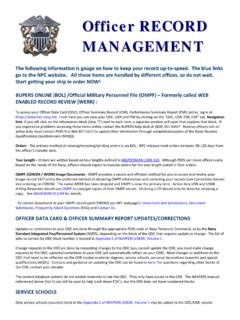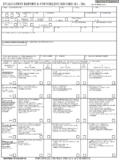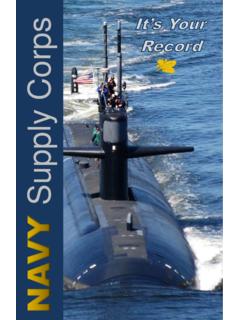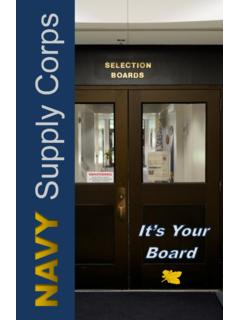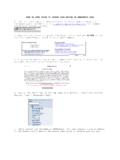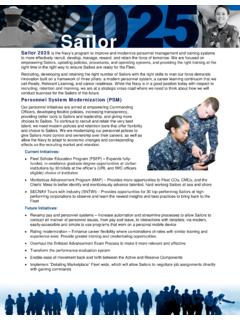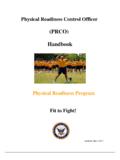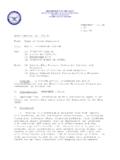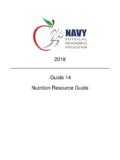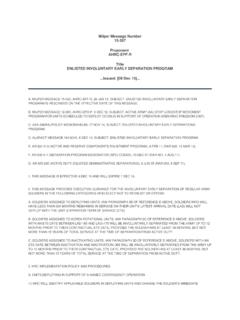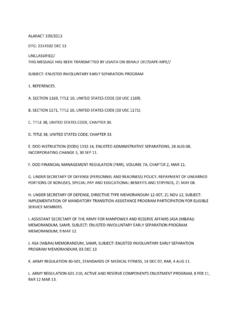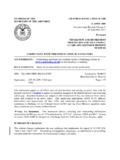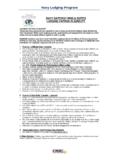Transcription of MILPERSMAN 1910-702 GENERAL GUIDANCE FOR …
1 1910 -702 CH-62, 3 Jan 2018 Page 1 of 4 MILPERSMAN 1910 -702 GENERAL GUIDANCE FOR SEPARATION AUTHORITIES (SA) Responsible Office NAVPERSCOM (PERS-832) Phone: DSN COM E-mail: 882-3045 (901) 874-3045 NAVPERSCOM CUSTOMER SERVICE CENTER Phone: 1-866-U ASK NPC References (a) SECNAVINST (b) Department of Defense Financial Management Regulation Volume 7A, Chapter 9 1. Separation Authority (SA) Pre-Decision Review: Prior to approving any involuntary administrative separation (ADSEP), the SA must take the following steps: a. Ensure a review of the Service member s record has been conducted to determine whether the Service member served in an imminent danger pay area in the 2-year period prior to initiation of ADSEP processing.
2 B. If the Service member has served in an imminent danger pay area, ensure that the member has completed all post-deployment surveys and medical evaluations. Involuntary separations will be held in abeyance until any required evaluations and follow-on diagnoses are complete. c. For involuntary separation cases, if a Service member has been diagnosed with post-traumatic stress disorder (PTSD) or a traumatic brain injury (TBI), a determination must be made as to whether the diagnosed condition was a contributing factor to the conduct forming one or more of the bases supporting the ADSEP. This determination must not be made by the SA, but by a mental health professional diagnosing the PTSD or TBI, or a higher-level mental health professional.
3 A Service member who has been diagnosed with PTSD must be evaluated by either a psychiatrist or a clinical psychologist. A Service member who has been diagnosed with a TBI must be evaluated by either a psychiatrist, clinical psychologist, or a treating physician. Evaluations must include specific comments on the presence or 1910 -702 CH-62, 3 Jan 2018 Page 2 of 4 absence of PTSD and or a TBI, and if present, the extent to which the diagnoses affected the Service member s judgment and behavior, and may have been a contributing factor in the basis for separation. Contact Navy Personnel Command (NAVPERSCOM), Enlisted Separations Branch (PERS-832) for further GUIDANCE .
4 Per MILPERSMAN 1910 -704, the Chief of Naval Personnel (CNP) is the SA for members diagnosed with either PTSD or a TBI who are being processed for involuntarily separation. If CNP determines that separation is still appropriate, the final decision document will specify that the member s medical condition evaluation was reviewed and considered prior to rendering a decision, and that separation was appropriate despite the Service member s medical condition. d. Determine if the member is also being processed by the Disability Evaluation System to identify dual processing cases. MILPERSMAN 1910 -216 refers. 2. Deliberating Final Action. In deliberating final action, SAs should understand the following: a.
5 SAs may not approve findings and characterization recommendations less favorable to the respondent than those rendered by an administrative board. b. If SAs believe that the respondent has been processed contrary to policy, and that the deviation from policy disparaged the enumerated rights of the respondent, or that the board s findings were obtained by fraud or collusion, the case may be referred to a new board made up of all new members. The new board may not make findings and recommendations less favorable than the member s previous board, unless the SA finds that fraud or collusion in the previous board was attributable to the respondent or to individuals acting on the respondent s behalf (witness, counsel, etc.)
6 C. Members confined in foreign jails may be processed for separation but may not be discharged or separated from the Service until the completion of imprisonment and return to the United States. In unusual cases, ( , life sentence without possibility of parole) separations may be authorized by the Secretary of the Navy per reference (a). d. SAs will ensure maximum recoupment of bonuses and debts to the Government prior to separation, when appropriate, per reference (b). 1910 -702 CH-62, 3 Jan 2018 Page 3 of 4 e. For every case that the recommended characterization of service of under Other Than Honorable conditions, the record of the board s proceedings will be reviewed by a judge advocate or civilian attorney employed by the Navy prior to action by the SA.
7 Typically, this review will be conducted by the SA s staff judge advocate (SJA), or if the SA has no SJA, the region legal service office should conduct this review. Such review is not required when another characterization (Honorable, GENERAL (Under Honorable Conditions), or Entry Level Separation) is recommended, unless the respondent identifies specific legal issues for consideration by the SA. f. Any SA can refer a case to NAVPERSCOM for final decision. This can be useful if unique circumstances are present. When an SA refers a case to NAVPERSCOM for final decision, the SA must provide reasons for the referral in an endorsement or letter of transmittal (as appropriate).
8 G. Members may not be involuntarily held past their end of active obligated service (EAOS) for the purpose of administrative separation processing. All review actions must be completed, the discharge authorized, and the DD-214 ready for delivery as of 2359 on the day of member s EAOS. If administrative separation processing cannot be completed prior to the member s EAOS, separate the member at EAOS with a characterization of discharge warranted by service record. Members may not be involuntarily held past their expiration of active obligated service (EAOS) for the purpose of administrative discharge processing; therefore, all review actions must be completed, discharge authorized, and the member s DD214 ready for delivery as of 2359 on the day of EAOS.
9 If this cannot be done, separate the member at EAOS with a discharge characterized by the service record review. MILPERSMAN 1910 -104 refers. The CO may assign an RE-4 reenlistment code (not recommended for reenlistment) and document such action on NAVPERS 1070/613 Administrative Remarks. NAVPERS 1070/613 may be accessed by using the following Web address: NAVPERS/ 1910 -702 CH-62, 3 Jan 2018 Page 4 of 4 3. Final Action When a Member is Not Separated a. If any basis for separation was met and the member is being retained in the Navy, the convening authority (CA) must issue NAVPERS 1070/613 counseling/warning per MILPERSMAN 1910 -204, outlining the deficiency ( , the board s findings and recommendations).
10 B. If no basis for separation was met and the SA finds no errors in the board, the SA should advise the CA in writing: No further action on the case is considered appropriate because member s administrative board of (date) found member did not commit [basis] as evidenced by (nonjudicial punishment, NCIS report, etc.).
